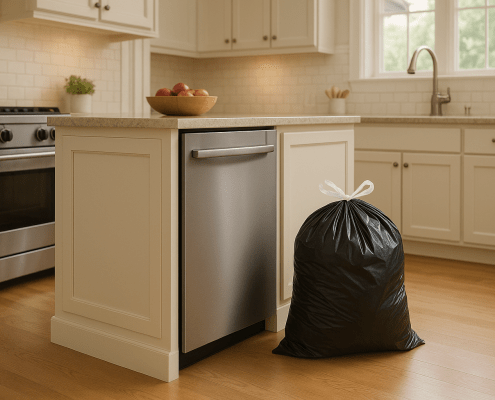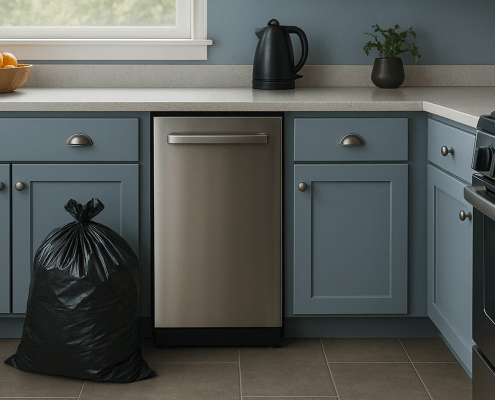Trash Compactor is Noisy: 5 Reasons and Fixes (With Video!)
APP Expert / Tuesday May 24, 2022
Is your trash compactor creating a cacophony of noises that’s driving you up the wall? Whether it’s banging, thumping, or screeching, these unusual sounds signal that it’s time for a little DIY intervention. Dive into our step-by-step guide, and don’t miss the companion video just below, to silence your compactor and restore peace to your kitchen!
Need a replacement part for your trash compactor? Search below using your specific compactor model number to identify the exact part needed:
Even trash compactors with sound dampening features make a little bit of noise when they run, but you don’t necessarily need to live with an appliance that’s making a ton of racket. Banging, thumping, screeching, and squealing sounds are all pretty unusual, and are usually signs that something in your trash compactor needs tightened down, adjusted, or replaced. Luckily, all of these parts are pretty easy to check and fix, and AppliancePartsPros.com is here to help out! We’ll have you on your way to diagnosing and fixing your noise problem in just a few minutes with this guide and the companion video tutorial. Let’s get started!
5 Major Causes Of A Noisy Trash Compactor
Regardless of the brand or model of your appliance, there are generally five components that can cause a ruckus in your trash compactor. In our tutorial video, we worked on a Whirlpool-manufactured appliance, and while certain components may be mounted in a slightly different place or secured by a different number of screws, you should still be able to use our guide to test out your trash compactor’s parts no matter the brand.
Before You Begin…
For your safety, be sure to disconnect the trash compactor from power, either at the wall outlet or via the circuit breaker. To avoid a nasty, potentially hazardous shock, never complete maintenance on an appliance that is still receiving power.
For a few of these tests, you’ll need to remove the compactor from between cabinets. Prep for this by removing any brackets securing it, or lowering the leveling feet so that it can be pulled out.All set? Let’s begin!
Testing Tools
While you won’t need all of these items for every test, it’s a good idea to have them all on hand before you begin:
- Screwdriver or nut driver, depending on what type of screws or bolts are holding your appliance together
- A basic socket set & ratchet
- Electrical tape
- A towel
- Paper
- Work gloves
1. Drive Gears
The drive gear system consists of two gears, one large and one small, and a number of other components, including a roll pin, ram stops, washers, and at least one retaining clip. These components can be found on the very bottom of your trash compactor, connecting the motor to the drive chain. Most drive gears are made of plastic, meaning they can wear down or break with age, making for a noisy compactor. If your trash compactor is making squealing, whining, banging, or thumping noises when in operation, it may be because of faulty drive gears.
To check this component, you’ll need a screwdriver or nut driver and a towel for sure, and potentially a basic socket set and some paper. Here’s what you do:
- Completely remove the trash compactor drawer and set it aside.
- Next, remove the trash compactor from its space beneath the counter. Depending on your trash compactor’s model, you may need to remove a mounting bracket or simply lower the leveling feet to clear it from the space.
- Lay a towel down and turn the compactor over onto its side. This will allow you to reach the bottom access panel.
- Remove the screws or nuts holding the access panel in place. There’ll likely be a few across the bottom and there may be one or two at the front of the compactor. Once these are out, you can remove the panel.
- Start your check-up with a visual inspection of the gears. Check both gears for cracks and worn down or missing teeth. If you notice any of these signs of damage, you’ll need to replace your drive gear kit.
- If the gears look alright, it’s time to check that everything is properly secure. In the next steps, we’ll give you instructions for checking and re-securing
- The adjustable mounting plate should be secure, and the chain should have about ⅜-inch of movement. If any of these components are loose, you may need to do some adjustment. To adjust, loosen the bolts securing the mounting plate just enough that you can pull the plate back. Pull the plate into position and hold it with one hand while tightening the bolts that secure it back down.
- The motor could also potentially be loose. Check the inner nuts on the adjustable plate – those are securing the motor – and the smaller of the two gears. If any of these are wobbly or loose, you may need to tighten down the motor.
- Start by loosening up all four of the motor nuts so that they’re roughly even.
- Run a piece of paper between the two gears, leaving it wedged between them. This will let you set the backlash. Don’t forget to check out our tutorial video if you’d like a look at how this is done!
- Using a socket and ratchet, tighten down each of the four nuts again, re-securing the motor.
- Remove the paper.
- If your trash compactor is still noisy after readjusting everything and checking the teeth on both gears, more than likely, the gears are out of tolerance. If this is the case, they’ll need to be replaced.
If you do need to replace the drive gears, you can generally buy them as a complete kit with hardware. The only additional thing you’ll need to purchase will be some lubricant, as the new gears should be lubricated after being installed.
2. Power Nuts
Most trash compactors have two power nuts, large plastic components with interior threading that ride on the power screw to move the compactor’s ram up and down. Exactly where these components are mounted will depend on the model and brand of your trash compactor. In our example, there was one mounted on each side of the ram, behind the access cover. As one or both of the power nuts wears out, you’ll likely start to hear a squeaking noise. The more worn the nut is, the louder the sound. Eventually, it will start making a thumping noise, as well.
To test the power nuts, you’ll need a nut driver or screwdriver and a bit of electrical tape.
- Again, start by completely removing the drawer and set it aside.
- Remove the compactor from the cabinets to reach the top access panel.
- Remove the screws holding the top access panel in place, then slide the panel back to remove it.
- Tape the switch arm out of the way of the ram.
- Lay down a towel, lay the compactor on its side, and remove the bottom access panel.
- Lift the ram. Turn the larger of the two gears counterclockwise until the ram is at the very top of the power screws.
- Remove the ram assembly from the compactor body. Put the compactor back on its feet and lift the ram straight out. It should come away easily.
- Inspect the nuts. Check for signs of wear, cracks, or stripped threading on the interior. If you notice any of this, the power nuts will need to be replaced.
3. Drive Motor
The trash compactor’s work horse, this component is an electric motor that drives the ram through the compacting cycle. It is generally located on the back of the trash compactor, behind an access panel. Most often, the motor causes noise because its bearings have worn out.
To get to and test the drive motor, you’ll need a nut driver or screwdriver.
- Start by removing the compactor from the cabinets. You’ll need access to the back of the appliance, so take the drawer out completely and set it aside, then remove the compactor itself.
- Remove the rear access panel. At the base of the compactor, there should be a metal housing covering the motor. Remove this.
- With access to the motor, start by checking that it’s mounted properly. If it’s loose, it could be causing noise as it runs, either because of vibration or misaligned gears, so tighten it down.
- If the motor is secure, but is still making unusual noises, it might need to be replaced to fix the problem. More than likely, the bearings have gone bad, and those cannot be individually replaced.
4. Drawer Rollers
Your trash compactor opens and closes on two sets of rollers – one set mounted to the frame of the compactor, and the other to the drawer. While the two sets look a little different, the rollers are generally composed of the same parts: a roller with a ball-bearing center, a mounting shaft, and a spacer.
If your compactor is noisy specifically when the drawer opens and closes, it could be that the rollers have failed.
- Remove the trash compactor drawer to start and inspect the rollers.
- Check the wheels for damage. You’ll want to look for cracks, chips, or flattened sides on each wheel. If any of the wheels are damaged, you should replace that set of rollers.
- Make sure each roller spins freely. They should offer no resistance when turned by hand. If they’re difficult to turn, or if they grind, then the bearings have worn out and the rollers need to be replaced.
5. Leveling Legs
Most trash compactors have two leveling legs at the front of the appliance, which can be raised or lowered to keep the compactor level and secure it within the cabinet space. These components consist of a long adjustment screw and rubber feet which dampen vibration.
If your trash compactor is making rattling noises while it runs, it’s possible that the leveling feet are improperly adjusted for the space, causing the compactor to hit the cabinets and counter. The rubber feet can also wear out if they are particularly old, causing excessive vibration or shaking.
- Remove the drawer, lay down a towel, pull the compactor out from the cabinets and lay it on its side on the towel. This will give you access to the legs.
- Start by checking that the legs both have rubber feet in good condition. If one of your legs is missing a foot or is missing altogether, you’ll need to replace it.
- Make sure that your leveling legs meet the floor when the compactor is upright. You can turn them to adjust their height. They should be holding the compactor completely level when it’s in the cabinet space.
Finding The Right Replacement Part
There’s a good chance you won’t need to replace anything to fix a noisy trash compactor, but sometimes the only way to fix an issue is with an entirely new component. If you’ve tracked down what’s wrong with your appliance and it’s a part that needs replacing, AppliancePartsPros.com is happy to help you get what you need. To start, locate your trash compactor’s model number, which you can find on a label somewhere on the appliance. It’s most likely inside the unit somewhere, so start by opening the drawer and checking around the door and inside of the cabinet. If you can’t find a sticker, you can consult your compactor’s manual for at least a partial model number.
Got the model number? Great! Type it in to the search at AppliancePartsPros.com to find a list of compatible parts. You can also browse our trash compactor parts page and narrow the search down by your compactor’s brand, if you weren’t able to find your full model number.
Wrapping Up
Now that you know what’s likely to be the cause of your noisy trash compactor, the only thing left to do is fix the problem. Whether you need a replacement part or further assistance, keep AppliancePartsPros.com in mind.
If you need any replacement parts for your appliances, you can enter your model number at AppliancePartsPros.com to locate and order them quickly. Most orders arrive in just two business days, and we have tons of great information in our repair help section and YouTube videos to help you troubleshoot.
Stay connected with the latest DIY tips, tutorial videos, and repair guides by following us on Facebook, Instagram, and Twitter. We love hearing about your repair stories and successes. If you need more help or want personalized guidance, feel free to contact or call us at 877-477-7278. We’re ready to help you take on your next project with confidence!
Since 1999, AppliancePartsPros.com has helped millions of people repair their broken appliances by providing high-quality original parts at well below retail prices, free support and troubleshooting, and award-winning customer service from an expert, friendly, US-based customer support team!
Hi! I’m Matt H., and I’m thrilled to be your guide through the world of appliance repair with over 25 years of invaluable experience in the industry.
From the early days of my career, I have been deeply passionate about appliances and their inner workings. Over the years, I’ve seen it all – from vintage models to the latest cutting-edge technology – and I’ve dedicated myself to mastering the art of repair. With a toolbox in one hand and a wealth of knowledge in the other, I’ve tackled every challenge that has come my way, learning and growing with each repair.
Join me as we dive into the intricacies of appliance repair. From step-by-step repair guides to explanations of common problems and their solutions, I’ll be here to simplify the repair process and empower you with the knowledge you need to keep your appliances running smoothly.
Feel free to explore our blog, ask questions, and leave comments – this platform is a space for learning, sharing, and growing together. Let’s work together to ensure that your appliances continue to serve you for years to come.
Thank you for joining me on this journey, and I look forward to being your go-to resource for all things related to appliance repair!





